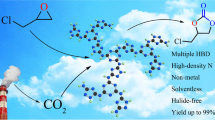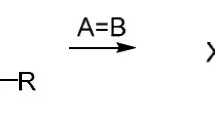Summary
We present a concise review of polymer-supported 1,3-dipolar cycloaddition reactions. Nitrile oxide and azomethine ylides constitute the two types of 1,3-dipoles which have been used in conjunction with solid-phase organic synthesis. These cycloaddition reactions on solid phase are generally of equal or greater efficiency than the analogous solution-phase reactions.
Similar content being viewed by others
References
Crowley, J.I. and Rapoport, H.,Solid-phase organic synthesis: Novelty or fundamental concept, Acc. Chem. Res., 9 (1976) 135–144.
Leznoff, C.C.,The use of insoluble polymer supports in general organic synthesis, Acc. Chem. Res., 11 (1978) 327–333.
Frechet, J.M.J.,Synthesis and applications of organic polymers as supports and protecting groups, Tetrahedron, 37 (1981) 663–683.
Hodge, P.,Organic reactions using polymer-supported catalysts, treagents or substrates, In Sherrington, D.C. and Hodge, P. (Eds.) Synthesis and Separations Using Functional Polymers, Wiley, New York, NY, U.S.A., 1988, pp. 43–122.
Thompson, L.A. and Ellman, J.A.,Synthesis and application of small molecule libraries, Chem. Rev., 96 (1996) 555–600.
Gordon, E.M., Barrett, R.W., Dower, W.J., Fodor, S.P.A. and Gallop, M.A.,Applications of combinatorial technologies to drug discovery. 2. Combinatorial organic synthesis, library screening strategies, and future directions, J. Med. Chem., 37 (1994) 1385–1401.
Huisgen, R.,1,3-Dipolar cycloadditions — Introduction, survey, mechanism, In Padwa, A. (Ed.) General Heterocyclic Chemistry Series, Vol. 1, Wiley, New York, NY, U.S.A., 1984, pp. 1–176.
Hansen, H.-J. and Heimgartner, H.,Nitrile ylides, In Padwa, A. (Ed.) General Heterocyclic Chemistry Series, Vol. 1, Wiley, New York, NY, U.S.A., 1984, pp. 177–290.
Caramella, P. and Grunanger, P.,Nitrile oxides and imines, In Padwa, A. (Ed.) General Heterocyclic Chemistry Series, Vol. 1, Wiley, New York, NY, U.S.A., 1984, pp. 291–392.
Regitz, M. and Heydt, H.,Diazoalkanes, In Padwa, A. (Ed.) General Heterocyclic Chemistry Series, Vol. 1, Wiley, New York, NY, U.S.A., 1984, pp. 393–558.
Lwowski, W.,Azides and nitrous oxide, In Padwa, A. (Ed.) General Heterocyclic Chemistry Series, Vol. 1, Wiley, New York, NY, U.S.A., 1984, pp. 559–652.
Lown, J.W.,Azomethine ylides, In Padwa, A. (Ed.) General Heterocyclic Chemistry Series, Vol. 1, Wiley, New York, NY, U.S.A., 1984, pp. 653–733.
Grashy, R.,Azomethine imines, In Padwa, A. (Ed.) General Heterocyclic Chemistry Series, Vol. 1, Wiley, New York, NY, U.S.A., 1984, pp. 733–817.
Tufariello, J.J.,Nitrones, In Padwa, A. (Ed.) General Heterocyclic Chemistry Series, Vol. 2, Wiley, New York, NY, U.S.A., 1984, pp. 83–168.
Kuczkowski, R.L.,Ozone and carbonyl oxides, In Padwa, A. (Ed.) General Heterocyclic Chemistry Series, Vol. 2, Wiley, New York, NY, U.S.A., 1984, pp. 197–276.
Torsell, K., Nitrile Oxides, Nitrones and Nitronates in Organic Synthesis, VCH Publishers, New York, NY, U.S.A., 1988.
Christensen, I.T., Ebert, B., Madsen, U., Nielsen, B., Brehm, L. and Krogsgaard-Larsen, P.,Excitatory amino acid receptor ligands-Synthesis and biological activity of 3-isoxazolol amino acids structurally related to homoibotenic acid, J. Med. Chem., 35 (1992) 3512–3519.
Mallamo, J.P., Diana, G.D., Pevear, D.C., Dutko, F.J, Chapman, M.S., Kim, K.H., Minor, I., Oliveira, M. and Rossman, M.G.,Conformationally restricted analogues of disoxaril — A comparison of the activity against human rhinovirus type-14 and type-1A, J. Med. Chem., 35 (1992) 4690–4695.
Koga, H., Sato, H., Dan, T. and Aoki, B.,Studies on uricosuric diuretics. 4. 3-Dimensional structure activity relationships and receptor mapping of (aryloxy)acetic acid dieretics, J. Med. Chem., 34 (1991) 2702–2708.
Chiarino, D., Grancini, G., Frigeni, V., Biasini, I. and Carenzi, A.,N-(4-Isoxazolylthiazol-2-yl)oxamic acid derivatives as potent orally active antianaphylactic agents, J. Med. Chem., 34 (1991) 600–605.
Kozikowski, A.P.,The isoxazoline route to the molecules of nature, Acc. Chem. Res., 17 (1984) 410–416.
Jager, V. and Grund, H.,Eliminative ring opening of 2-isoxazolines: A new route to α,β-unsaturated ketones, Angew. Chem. Int. Ed. Engl., 15 (1976) 50–51.
Curran, D.P. and Chao, J.-C.,Control of relative stereochemistry in the cycloadditive route to β-hydroxy carbonyls. Stereoselective exo aldol reactions of Δ 2 -isoxazolines, Tetrahedron, 46 (1990) 7325–7339.
Kawai, M., Nishikomor, R., Jung, E.-Y., Tai, G., Yamanaka, C., Mayumi, M. and Heike, T.,Pyrrolidine dithiocarbamate inhibits intercellular adhesion molecule-1 biosynthesis induced by cytokines in human fibroblasts, J. Immunol., 154 (1995) 2333–2341.
Petrillo, E.W. and Ondetti, M.A.,Angiotensin-Converting Enzyme Inhibitors: Medicinal chemistry and biological actions, Med. Res. Rev., 2 (1982) 1–41.
Kanemasa, S., Sakamoto, K. and Tsuge, O.,Nonstabilized azomethine ylides generated by decarboxylative condensation of α-amino acids — Structural variation, reactivity and stereoselectivity, Bull. Chem. Soc. Jpn., 62 (1989) 1960–1968.
Grigg, R.,Prototropic routes to 1,3- and 1,5-dipoles and 1,2-ylides: Applications to the synthesis of heterocyclic compounds, Chem. Soc. Rev., 16 (1987) 89–121.
Fleming, I.,Thermal pericyclic reactions, In Fleming, I. (Ed.) Frontier Molecular Orbitals and Organic Chemical Reactions, Wiley, London, U.K., 1976, pp. 148–161.
Yedidia, V. and Leznoff, C.C.,Regioselectivity in cycloaddition reactions on solid phases, Can. J. Chem., 58 (1980) 1144–1150.
Christl, M., Huisgen, R. and Sustmann, R.,Zur anlagerung des benzonitriloxids an α,β-ungesattigte carbonsaureester, Chem. Ber., 106 (1973) 3275–3290.
Beebe, X., Schore, N.E. and Kurth, M.J.,Polymer-supported synthesis of 2,5-disubstituted tetrahydrofurans, J. Am. Chem. Soc., 114 (1992) 10061–10062.
Beebe, X., Schore, N.E. and Kurth, M.J.,Polymer-supported synthesis of cyclic ethers: Electrophilic cyclization of isoxazolines, J. Org. Chem., 60 (1995) 4196–4203.
Kurth, M.J., Rodriguez, M.J. and Olmstead, M.M.,Tandem 1,3-dipolar cycloaddition and electrophilic cyclization reactions — Cyclic ether subunits of polyether antibiotics from unsaturated isoxazolines, J. Org. Chem., 55 (1990) 283–288.
Ford, W.T.,Site isolation organic synthesis in polystyrene networks, In Ford, W.T. (Ed.) Polymeric Reagents and Catalysts, Am. Chem. Soc., Symp. Ser. 308, American Chemical Society, Washington, DC, U.S.A., 1986, pp. 247–285.
Patchornik, A. and Kraus, M.A.,Reactive species mutually isolated on insoluble polymeric carriers. I. The directed monoacylation of esters, J. Am. Chem. Soc., 92 (1970) 7587–7589.
Beebe, X., Chiappari, C.L., Olmstead, M.M., Kurth, M.J. and Schore, N.E.,Polymer-supported synthesis of cyclic ethers: Electrophilic cyclization of tetrahydrofuroisoxazolines, J. Org. Chem., 60 (1995) 4204–4212.
DeWitt, S.H. and Czarnik, A.W,Combinatorial organic synthesis using Parke-Davis's DIVERSOMER method, Acc. Chem. Res., 29 (1996) 114–122.
Armstrong, R.W., Combs, A.P., Tempest, P.A., Brown, S.D. and Keating, T.A.,Multi-component condensation strategies for combinatorial library synthesis, Acc. Chem. Res., 29 (1996) 123–131.
Ellman, J.A.,Design, synthesis, and evaluation of small-molecule libraries, Acc. Chem. Res., 29 (1996) 132–143.
Gordon, E.M., Gallop, M.A. and Patel, D.V.,Strategy and tactics in combinatorial organic synthesis. Application to drug discovery, Acc. Chem. Res., 29 (1996) 144–154.
Still, W.C.,Discovery of sequence-selective peptide binding by synthetic receptors using encoded combinatorial libraries, Acc. Chem. Res., 29 (1996) 155–163.
Hsieh-Wilson, L.C., Xiang, X.-D. and Schultz, P.G.,Lessons from the immune system: From catalysis to material science, Acc. Chem. Res., 29 (1996) 164–170.
Miller, S.M., Simon, R.J., Ng, S., Zuckermann, R.N., Kerr, J.M. and Moos, W.H.,Comparison of the proteolytic susceptibilities of homologous l -amino acid,d-amino acid, and N-substituted glycine peptide and peptoid oligomers, Drug Dev. Res., 35 (1995) 20–32.
Pei, Y. and Moos, W.H.,Post-modification of peptoid side chains: [s+2] Cycloaddition of nitrile oxides with alkenes and alkynes on the solid-phase, Tetrahedron Lett., 35 (1994) 5825–5828.
Brossi, A.,175 years of isoquinoline drugs, Heterocycles, 11 (1978) 521–547.
Lorsbach, B.A., Miller, R.B. and Kurth, M.J.,Reissert-based ‘traceless’ solid-phase synthesis: Isoquinoline and isoxazoline containing heterocycles, J. Org. Chem., 61 (1996) 8716–8717.
Boekelheide, V. and Weinstock, J.,Reissert compounds. Further alkylation studies and a novel rearrangement, J. Am. Chem. Soc., 74 (1952) 660–663.
Hughes, I.,Application of polymer-bound phosphonium salts as traceless supports for solid phase synthesis, Tetrahedron Lett., 37 (1996) 7595–7598.
Plunkett, M.J. and Ellman, J.A.,A silicon-based linker for traceless solid-phase synthesis, J. Org. Chem., 60 (1995) 6006–6007.
Chenera, B., Finkelstein, J.A. and Veber, D.F.,Protodetachable arylsilane polymer linkages for use in solid phase organic synthesis, J. Am. Chem. Soc., 117 (1995) 11999–12000.
Sucholeiki, I.,Solid-phase photochemical C-S bond cleavage of thioethers — A new approach to the solid-phase production of non-peptide molecules, Tetrahedron Lett., 35 (1994) 7307–7310.
Kurth, M.J., Randall, L.A.A. and Takenouchi, K.J.,The solidphase combinatorial synthesis of polyisoxazolines: A two reaction iterative protocol, J. Org. Chem., 61 (1996) 8755–8761.
Mortier, R.M., Paton, R.M., Scott, G. and Stobie, I.,Nitrile sulphides. Part 8. Polymer-bound nitrile sulphides: generation from polymeric 1,3,4-oxathiazol-2-ones, and 1,3-dipolar cycloaddition reactions, Br. Polym. J., 19 (1987) 303–312.
Costero, A.M., Pitarch, M. and Cano, M.L.,Azet-2(3H)-one as a dipolarophile in 1,3-dipolar cycloadditions, J. Chem. Res. (S), (1994) 316–317.
Gavina, F., Costero, A.M. and Andreu, M.R.,Reaction of 4-substituted 2-azetidinone with nucleophiles — Existence and reactivity of 1-azetin-4-one, J. Org. Chem., 55 (1990) 434–437.
Hamper, B.C., Dukesherer, D.R. and South, M.S.,Solid-phase synthesis of proline analogs via a three component 1,3-dipolar cycloaddition, Tetrahedron Lett., 37 (1996) 3671–3674.
Murphy, M.M., Schullek, J.R., Gordon, E.M. and Gallop, M.A.,Combinatorial organic synthesis of highly functionalized pyrrolidines: Identification of a potent angiotensin converting enzyme inhibitor from a mercaptoacyl proline library, J. Am. Chem. Soc., 117 (1995) 7029–7030.
Furka, A., Sebestyen, F., Asgedom, M. and Dibo, G.,General method for rapid synthesis of multicomponent peptide mixtures, Int. J. Pept. Protein Res., 37 (1991) 487–493.
Bicknell, A.J. and Hird, N.W.,Synthesis of a highly functionalized rigid template by solid phase azomethine ylide cycloaddition, Bio. Med. Chem. Lett., 6 (1996) 2441–2444.
Author information
Authors and Affiliations
Rights and permissions
About this article
Cite this article
Kantorowski, E.J., Kurth, M.J. Dipolar cycloadditions in solid-phase organic synthesis (SPOS). Mol Divers 2, 207–216 (1997). https://doi.org/10.1007/BF01715636
Received:
Accepted:
Issue Date:
DOI: https://doi.org/10.1007/BF01715636




